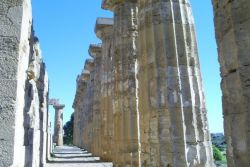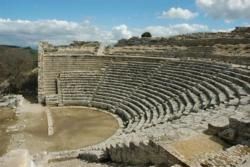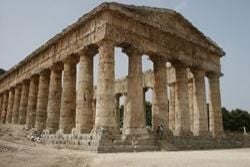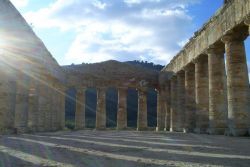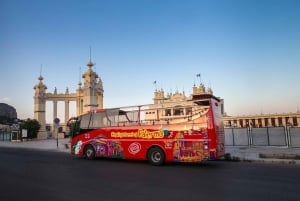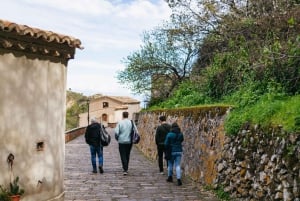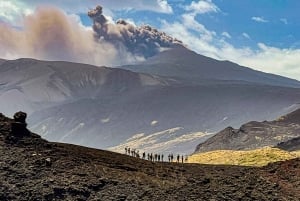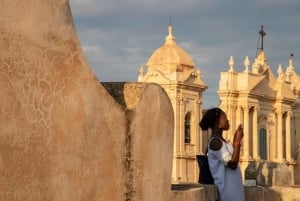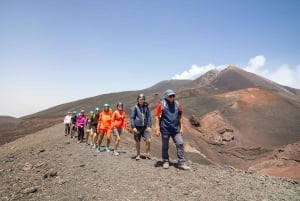Segesta
Driving from Trapani to Palermo, whilst admiring the beautiful hilly landscape, very often the driver will hear “Hey, stop for a minute, I am not sure but I think I just saw a Greek temple in the middle of nowhere. Am I hallucinating?” No, no hallucination, your co-passenger just saw the Temple of Segesta, which was constructed on the side of a hill that is surrounded by a rolling green countryside and has a marvellous vista stretching down to the sea. If you have been to Perge and Aspendos in Turkey, or in Sicily already have visited to Taormina, Agrigento and Selinunte, and still need one more proof that the old Greeks really had an eye for where to build their towns, Segesta will lay any doubts to rest once and for all.
The ancient town was actually built by the Elymians, one of Sicily's indigenous peoples, who also founded Erice, but Greek colonists started to build this impressive temple between 430 and 420 BC, which is 26 metres wide, 61 metres long, and features 36 Doric columns. Archaeologists believe that the temple was actually never finished: it was never roofed over, its columns were not fluted and there are still tabs at the blocks of the base for lifting them into place.
.
(Video by courtesy of Todaro Net)
From the beginning Segesta was in eternal conflict with Selinunte, the first battles started in 580 BC. In 415 BC Segesta asked Athens for help, which led to a two year Athenian expedition in Sicily. Later Segesta allied with the Carthaginians, who destroyed the ancient Selinunte completely. For nearly twenty years Carthage and Segesta remained allied, but Segesta was besieged by the tyrant Dionysius of Syracuse in the year 397 BC, later destroyed by Agathocles, then forced to surrender the Romans who granted the town the state of a free and immune city. Then it was razed by the Vandals.
Given this very vivid history it is amazing that something of this town has survived at all.
Some steps down from the temple is a large panoramic terrace where you can rest after your sightseeing. Just sit down on one of the stone benches and admire the great views. After some minutes you will feel something very strange: you will become totally calm and feel completely “in peace with yourself”. It is like everything falls off, your problems and thoughts seem to vanish. We think that this place has a strong magnetic power like, for example, the pyramids of Giza in Egypt, and that, apart from their good eye for stunning locations, the old Greeks felt the same.
Architectural barriers have been removed, so the Archaeological Park is easily accessible also for people with physical problems.
The temple area is still under exploration and from time to time you can see archaeologists at work. Current archaeological work indicate that the site was reoccupied in the Norman period by a Muslim community, excavations have unearthed a mosque and a Muslim necropolis form the 12th century. The city of Segesta itself appears to have been abandoned in the 13th century.
Teatro di Segesta
On top of Monte Barbaro there is theatre which was built around the same time the temple was constructed. It can contain up to 4000 people. Every year in summer, different performances take place. Please note that the theatre of Segesta is not accessible to wheelchair users, only the temple area is. The theatre features impressive views of the plains and the Bay of Castellammare del Golfo, especially at sunset.
Sanctuary & Agora
Another important attraction of Segesta is represented by the shrine, which is located outside the ancient city walls and was built in the 6th century BC. Archaeologists are still trying to figure out what led the Elymians to construct this shrine. They know nothing about its cultural destination. Also worth a visit are the Greek Agora, the “market place” and the “House of Navarca”, which was obviously a residential building of some value, due to its decoration.
Terme Segestane
The waters of the thermal baths of Segesta have specific therapeutic indications and are used for skin treatments, respiratory and muscular-skeletal diseases. The baths’ temperature is around 46-47° C, and they are classified as hypo-thermal salt-sulfur radioactive springs. You will find therapeutic, mud and whirlpool baths, sauna caves, hot and humid inhalations, spa pools, and nasal irrigation and massages.
In Ponte Bagni near the archaeological site are the free thermal baths. These are hot sulfur springs, and a good opportunity to enjoy the benefits of the baths of Segesta for free. In case of night visits don’t forget a torch.
Restaurants & Accommodation
There is a big restaurant near the archaeological site with 460 seatings, 200 outside and 260 inside – so you won’t have to eat alone. Other restaurants and bars are to be found in Calatafimi, Alcamo, Salemi and Castellammare del Golfo which is only 15 km away.
Segesta is an archaeological site, there is no accommodation available. Trapani, Alcamo, Scopello and Castellammare del Golfo are near, so it is best to choose from the array of accommodation there.
Events
Biggest yearly event in the theatre of Segesta is the Calatafimi – Segesta Festival “Mito, Storia e Musica” – myths, history and music at the ancient theatre, which takes place in July. Find more festivals in Sicily here
My Guide Sicily Tip – A Day in Segesta
In the morning visit to the archaeological site. For lunch, if you want to avoid the crowds in the only restaurant, take a picnic with you - fresh bread, local cheese, some salami and a bottle of Sicilian red wine will do fine. Sit down in the shade of an olive tree and enjoy it all, food, drink and the beautiful views. After lunch you could spend a little time in the thermal baths and get pampered. Or you dip in the hot-water river to fill up your energies, just like Aeneas and Heracles did.
How to get to Segesta
By car
Take the A 29 from Palermo to Trapani – the site has its own exit. From here it is a short one kilometer drive to the parking lots of Segesta. Distance to Palermo: 70 km, distance to Trapani: 30 km. If you are staying in the east of the island, at Taormina or Messina, you will have to cross whole Sicily. The temple can be clearly seen from the motorway, you cannot miss the exit.
By bus & train
Three or four daily buses from Trapani (AST). Train connections with Palermo and Trapani. From station Segesta-Tempio 20 minute uphill walk to the entrance of the archaeological site (800 m).


